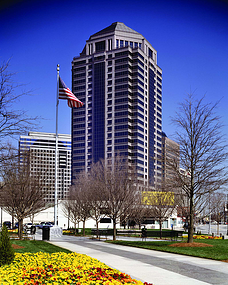Automatic Flow Control and MFT Means Partially Occupied Buildings are More Efficient
Is the commercial office building half full or is it half empty?
If you are optimistic about the US commercial real estate market than you might say it is half full, but if you are a commercial property owner, developer or manager, that doesn’t make you any less concerned about the current state of commercial real estate. The fact is, office vacancies in the U.S. rose to the highest level since 1993 in the second quarter of 2010.
Vacant commercial building space consumes approximately 2.7kWh/ft² annually. This is approximately 1/10 --1/6 normal energy consumption for most building types. Given the current slump in office leasing, it makes a property owner or manager wonder – how do you operate a partially occupied building for maximum efficiency? And how to you seamlessly adjust when the building space is finally leased?
If you are responsible for the energy  management for a Class A office space like 1100 Peachtree in Atlanta, you make sure your space has direct digital control (DDC) with automatic flow control to air handling units, fan coil units, variable air volume boxes, etc. The high end property underwent a very successful DDC retrofit using Belimo Pressure Independent Characterized Control Valves (PICCVs) to replace existing pneumatic control valves. This approach not only assured long term efficiency, regardless of total building load, but a consistency in space temperature for tenants.
management for a Class A office space like 1100 Peachtree in Atlanta, you make sure your space has direct digital control (DDC) with automatic flow control to air handling units, fan coil units, variable air volume boxes, etc. The high end property underwent a very successful DDC retrofit using Belimo Pressure Independent Characterized Control Valves (PICCVs) to replace existing pneumatic control valves. This approach not only assured long term efficiency, regardless of total building load, but a consistency in space temperature for tenants.
Pneumatic Versus Electronic Control
Pneumatically controlled systems lose accuracy over time, making it difficult to deliver accurate flow through valves at low loads causing large temperature swings and increasing tenant complaints. In contrast, digitally controlled automatic flow control valves adjust seamlessly to the building load—so whether you are 25% occupied or 100% occupied, consistent space temperatures are maintained.
Given the volatility of commercial real estate (particularly office space) it makes sense to equip these spaces with HVAC components that can go with the flow. That not only means being able to adjust for low load periods, but also increases in occupied space, with as little interruption as possible. Standard pneumatic systems must be rebalanced as new zones come on line, causing extra expense for property owners. DDC controlled automatic control valves, however, require no rebalancing because they are designed to maintain proper flow despite pressure changes in the system.
Pneumatic actuators limit the capability of Direct Digital Controls (DDC), which prompts many building engineers to look into converting to electronic actuators. In these cases, making sure the new actuators are compatible with the existing DDC system is always a concern. Belimo has resolved many compatibility issues with its MFT actuator. This actuator, which incorporates Multi-Function Technology®, can be configured for a Pulse Width Modulation (PWM) control input that is common in both old and new systems. This allows owners to reach a whole new level of modulating control.
MFT actuator technology from Belimo is applicable to both dampers and flow control valves, providing an all-in-one solution for any building owner who wants to ramp up their control strategy. It is a move that not only improves the comfort of an office space, but one that allows the owner to increase the efficiency of a partially occupied building.
Universal access to all MFT actuators with Belimo PC-Tool. The PC-Tool is a universal software application for setting, commissioning, monitoring and evaluating communications with Belimo actuators. Actuators are normally delivered with the basic settings. They can be individually programmed using the PC-Tool and precisely adjusted to the requirements of the system. Service related diagnostics for the actuators are extremely easy with the PC-Tool. Setpoints can be specified and actual values monitored. The trend recording function can output the information in a graphical format for system documentation.
Try it now for FREE! The PC-Tool software normally sell for $140.00.

